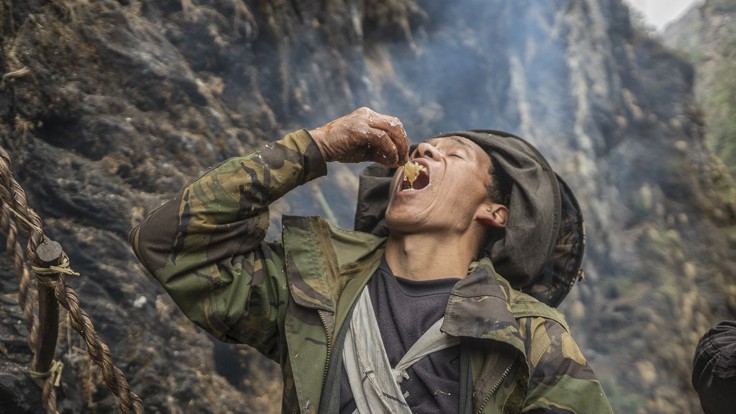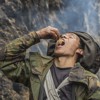Sweet Gold (Honey Hunting Trek) - 9 Days
Unknown
Since 2018, HoneyGuide has worked with over 1000 independent/group trekkers, 200+ Lodges and 230+ Local Guides/Porters in the Everest Region.
As a concierge, HoneyGuide will:- Answer your queries and help you make an itinerary as per your budget, preference and time.
- Recommend and help you book Flights, Guides/ Porter and Lodges in every night stop at best rates.
- Full trail support- If any changes occur, we will change your scheduled bookings for free.
We are featured by
BASIC INFORMATION
2
Minimum Size6
Maximum Size
HIGHLIGHTS
- Experience the Honey Harvesting process in the remote hills of Western Nepal.
- Exotic Wilderness with primitive delicacies.
- Crossing the same river over 25 times
- Cultural Dance (Thali Dance)
QUICK FACTS
- Difficulty LevelHard
- Total Length35 km
- Highest Altitude2,500 meters
- Elevation Profile
- Start locationDagnam
- Finish locationDagnam
- PermitsNot required
- Best SeasonApril
DAY TO DAY ITINERARY
DESCRIPTION
Get ready for a your once in a lifetime experience with this 9 days exclusive trek in the remote mid hills of Western Nepal. This adventurous journey will take you through the untouched wilderness amidst the green echoing hillsscape of Myagdi district.
You will cross the same river (without actual bridges) over 25 times in a day, enjoy the crazy local delicacies (including fried frogs), camp under the cave and eventually witness one of the most daring process of honey harvesting by one of the ethnic tribes of Nepal, Garbuja Magars.
On the way back, you will get a chance to sink in the local hospitality with a unique 'Thali' dance (a cultural dance performed by women with plates in their hands) of Dagnam village as a farewell! Definitely not for faint hearted. ;)
FAQS
Traveling to the mountains poses some inherent risks. As such, the best strategy is to prepare for the worst and then hope for the best.
PRE-EXISTING CONDITIONS
The first thing to keep in mind is to see if you have pre-existing conditions that could cause complications at high altitudes. Specifically, suppose you have sickle cell disease, pulmonary hypertension, obesity hypoventilation syndrome, or congenital heart problems. In that case, we highly recommend you consult with a qualified physician before planning a trip to the mountains. Read more.
ALTITUDE-ILLNESS
Given the low amount of oxygen at high altitudes, a sensible ascent is essential to give your body the time to acclimate to the thin air. Failure to do so can lead to your lungs or brain filling up with water leading to death in some cases. The key is not to climb more than 500 meters in one day once you pass the 2,500 meters mark. Read more.
ENVIRONMENTAL HAZARDS
Given the extreme weather in the high mountains, proper gear and regimen must have a safe and comfortable tour. The three most important things that you have to prepare for are cold, snow, and radiation. As such, invest in the right sunglasses, sunscreen, boots, and clothing. Read more.
TRAVEL INSURANCE
We highly recommend everyone get travel insurance covering high altitude evacuation before leaving on a trek to the high mountains. Global Rescue and World Nomads are both highly recommended. For Nepali travelers, please note that insurance that covers helicopter rescue is not available as of now. As such, please be careful while planning your tour and only work with companies that can provide timely evacuation service if needed.
RESCUE AND EMERGENCY
As health facilities are limited in the mountains, a helicopter's evacuation is usually the only option during an emergency. As such, the right insurance provider is essential. If you are not buying insurance for some reason, please ensure that there is someone in Kathmandu who can coordinate payments for a helicopter rescue. Here are some other contacts that might come in handy during an emergency. If you still have questions, please feel free to call / whatsapp us at +977-9801916215 or email Ashish at nectar@honeyguideapps.com
HOW DO I MAKE A PAYMENT?
To confirm your tour, you will have to make complete payment either through one of your integrated payment gateways or transfer the funds to the following bank accounts:
For Nepali citizens:
Account Name:: HoneyGuide Pvt. Ltd. Beneficiary Bank: Himalayan Bank, Patan Branch Account Number: 00606903770018For Indian Citizens:
For USD transfers
Account Name: HoneyGuide Apps, Inc. Bank Name: Silicon Valley Bank Account Number: 3302225311 Swift Code: SVBKUS6S ABA Routing Number: 121140399BOOKING A TOUR
Deposit Required for Reservation: 50 percent of total tour cost Deadline for Full Payment: 2 weeks before the tour begins
CHANGING A TOUR
Two weeks before tour date: No extra charge 1 to 2 weeks before tour date: 10% additional charge Two days to 1 week between tour date: 20% additional charge Within two days of tour date: Above 30% (variable)
CANCELLING A TOUR
Two weeks before tour date: No charge (transaction charges may apply) One to two weeks before tour date: 20% Cancellation Charge Two days to one week between tour date: 50% Cancellation Charge Within two days of tour date: No Refund.
DELAYS AND CHANGES DURING THE TOUR
In case of flight delays/cancellations due to bad weather or unforeseen circumstances, HoneyGuide will change the dates at no additional costs. However, any extra cost incurred, including but not limited to accommodation and food, will be the responsibility of the traveler.
In case of changes due to the trekker's health issues, HoneyGuide will make all the changes without any additional cost. However, any extra charge because of the changes will be the responsibility of the traveler.
While Nepal's mountains see six seasons, the best period to go to the mountains is from March-May and September-December. However, every season has its quirk, just like people. So keep reading to find your match.
For those going to Everest Region, do check out the Best time to go to Everest post.
January/February (Winter)
January/February is a good time for trekkers willing to brave the cold and snow for empty trails, fantastic mountain views, and wildlife sightings.
March/April (Spring)
This is a period that offers a little bit of everything: a little bit of mountain view, a little bit of warm weather, a little bit of flowers, a little bit of crowd, and a whole lot of fun.
May/June (Summer)
This is the best time for those into nature. The flowers are quite something this time of the year, and the bird activity is fantastic. The monsoon hasn't started, and as such, mornings are still clear with beautiful mountain views.
July/August (Monsoon)
Only for hardcore trekkers who are willing to put up with the elements for an authentic cultural experience and high altitude flowers. Also, flight disruptions are very likely, and chances of mountain views are close to zero.
September/October (Fall)
This period is everyone's darling, and the trails are as crowded as they can be. The mountain views are something to write home about, and the temperature is just perfect.
November/December (Pre-Winter)
Another popular period among trekkers and the driest two months in the calendar. Indeed it has gotten a bit nippy during the mornings and evenings, but it is still manageable. Count on a lot of sunshine and crystal clear mountain views.




